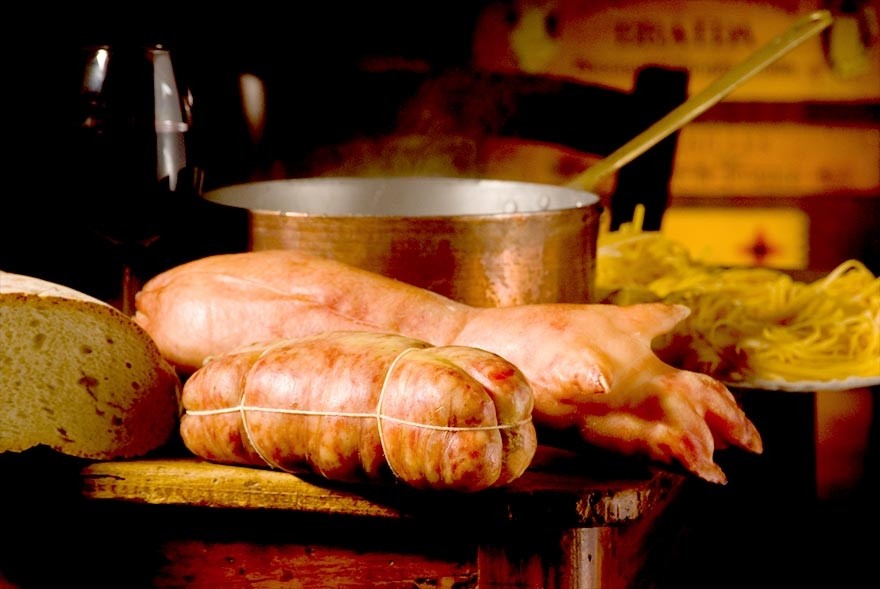Zampone Modena P.G.I.
Production method
Zampone Modena PGI is a raw or cooked charcuterie product made from pork and pork rind.
Production method
Zampone Modena PGI is made from a mixture of pig meat obtained from striated muscles, pork fat, rind, salt and whole or ground pepper.
The meat is ground in meat mincers with molds that have holes of 7-10 mm for the muscular parts and 3-5 mm for the rind.
The mince is mixed in a vacuum or atmospheric pressure machine, together with salt and/or wine, water, spices and aromatic plants.
The mixture is inserted into natural casings made from the skin of the anterior limb of the pig, complete with the distal phalanges, and tied at the top.
The final product can be sold fresh or cooked. In the first case, it is subject to a drying process, in the second, it is pre-cooked in water.
Apparence and flavour
Zampone Modena PGI has the typical shape of a pig’s anterior trotter.
It has a soft consistency and the slices are compact, with uniform grain and a pinkish to red colour.
The flavour is characteristic, with a very strong and aromatic taste.
Gastronomy
Fresh Zampone Modena PGI should be stored in the fridge and must be well cooked before serving.
Pre-cooked Zampone Modena PGI, packaged in airtight containers and heat treated, can be stored at room temperature for a longer period of time.
It requires a shorter cooking time, generally from 15 to 20 minutes. Zampone Modena PGI is served hot and sliced, together with lentils or stewed white beans, spinach, mashed potatoes and apple sauce, traditionally over Christmas and New Year. However, it can be enjoyed year-round with stewed white beans, spinach and butter, potato puree and apple sauce. Among the various recipes to try are “Zampone Modena on a bed of orange-fragranced cabbage with Aceto Balsamico di Modena PGI” and the particularly original “Zampone Modena PGI with Thai spaghetti, vegetables and soybeans, with an oyster and sesame seed sauce”.
It should be paired with sparkling red wines such as Modena’s classic Lambrusco PDOs.
Marketing
The product is marketed as Zampone Modena PGI. It is sold fresh, both packaged or unpackaged, or cooked and in suitable watertight packs.
In both cases, it is sold year-round, in a single piece with an approximate weight of 1 kg.
Distinctive features
The use of smoking aromas, or other aromas obtained by chemical synthesis, is not permitted during the production process of Zampone Modena PGI.
It has a high content of proteins, unsaturated fats (in respect to saturated fats), vitamins B and minerals such as iron and zinc.
History
The origins of Zampone Modena PGI date back to 1511, when the citizens of Mirandola (in Modena) were besieged by the army of Pope Julius II della Rovere, and decided to slaughter the pigs so that they would not be taken. At first they packed the meat into the rind, creating the Cotechino, and later into the pig trotters, thereby “inventing” Zampone.
The product was extremely successful and started being sold in the neighbouring markets at the beginning of the XVIII century, also thanks to the growth in production by historic charcuterie like Frigeri and Bellentani.
Production area
The production area of Zampone Modena PGI is within the entire territory of the Emilia-Romagna region; the territory of the provinces of Cremona, Lodi, Pavia, Milan, Monza and Brianza, Varese, Como, Lecco, Bergamo,
Brescia and Mantua in the Lombardy region; the provinces of Verona and Rovigo, in the Veneto region.
Operators: ND
Production(KG): 1.457.951
Turnover(MLN€): 10,25

 IT
IT 